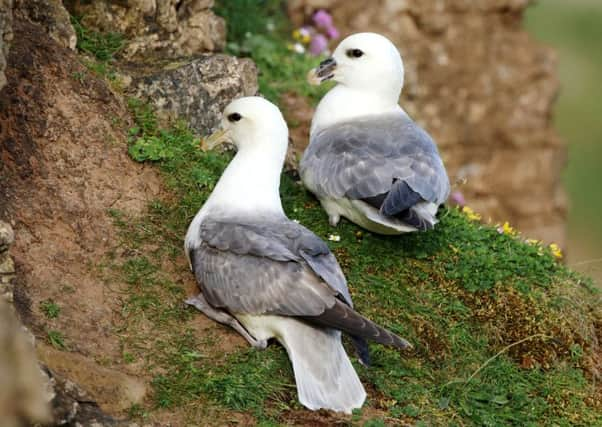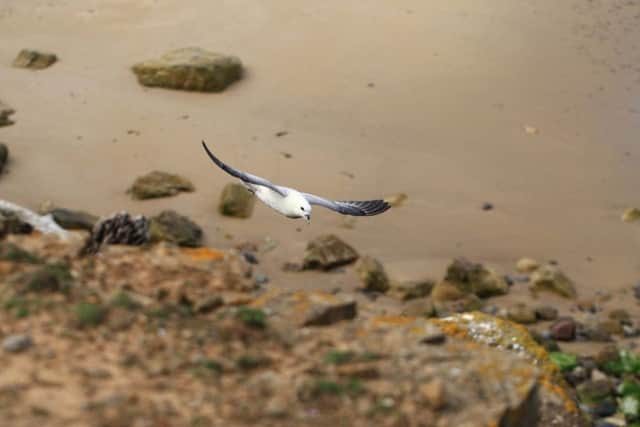NATURE NOTES: Fulmars – the reincarnated souls who have kept their sense of humour


A few feet below, a hoarse cacklingsignalled the presence of that compelling cousin of the albatross: the Northern fulmar, Fulmaris glacialis.
It was a diversion, this, from another farmland bird survey.


Advertisement
Hide AdAdvertisement
Hide AdBinoculars slung over shoulders, we walked through the dunes as lapwings displayed noisily overhead and made our way to Holy Island’s sea cliff.
It was a clear day, with good views out to sea.
Settling near the cliff edge, we heard a piping sound and adjusted our eyes to spot a small rock pipit below.
In the water, not far out, a dapper pair of eider ducks.
Then, passing before us almost at eye height, a pale shape gliding by, stiff-winged and silent.
Fulmars fly seemingly without effort, shifting position to glide with – and yet much faster than – the wind, a technique known as ‘dynamic soaring’.
Advertisement
Hide AdAdvertisement
Hide AdLike their albatross relatives, who can go for days without beating their wings, fulmars make use of the wind currents in ways humans are still trying to fathom.
Fulmars are a medium sized seabird, superficially gull-like, with pale grey upper and white underparts.
On water, they are buoyant and sit very upright, while on land they cannot stand or walk, managing at best an ungainly shuffle.
On cliff faces fulmars make noisy neighbours.
Their throaty chuckling and cackling rises and diminishes in volume, sounding alarmed and companionable in turns.
Advertisement
Hide AdAdvertisement
Hide AdThey nest mostly on grassy ledges near the tops of cliffs, though sometimes on the ground, particularly on islands.
They often live up to fifty years old, remaining largely loyal both to partners and nesting sites.
They are true seabirds who come inland only to breed.
Their single white egg is laid by the start of June, but this is just the beginning – 50 days of incubation follow, and then 50 more until the chick fledges.
It is an exercise in patience. Perhaps they are cackling about the discomfort of incubation, the difficulties of a desirable residence by the sea or the trials of parenthood.
Advertisement
Hide AdAdvertisement
Hide AdFulmar chicks are endearing pale grey bundles of fluff. Nothing could appear so innocent or defenceless – nor, to a predatory eye, such an easy meal.
However, all is not as it seems.
These dark-eyed, downy babies come equipped with a startling defence mechanism – the high-pressure expulsion of a foul-smelling oil. This clogs up the wings of aerial predators.
Safer by far to leave well alone.
Both chicks and adults produce this pungent oil – useful not only for defence, but as energy-rich nourishment for long journeys or to feed their young.
The oil gives the birds their name – the Old Norse ‘fúll’, or ‘foul’ and ‘már’ or ‘gull’.
Advertisement
Hide AdAdvertisement
Hide AdIn W.B. Lockwood’s Linguistic Notes on Fulmar, he notes the Viking origins of the word – and that only one who had been up close to a fulmar’s nesting site would know to call the bird ‘foul’.
Fulmars have been ‘fulmars’ then since at least the 1300s.
The word was assimilated into Gaelic, and then into English, and then into the bird’s scientific name.
Records from the 1800s show that on St Kilda, islanders made great use of the bird – the Northumbrian engraver and author Thomas Bewick wrote that ‘the Fulmar supplies them with oil for their lamps, down for their beds, a delicacy for their tables, a balm for their wounds, and a medicine for their distempers’.
At this time, fulmars were only occasional visitors to the British mainland, with St Kilda being their main breeding station.
Advertisement
Hide AdAdvertisement
Hide AdHowever, in the past 200 years the birds have spread, with their population in the north east Atlantic increasing dramatically until the 1970s owing to the increase in commercial fishing.
They are great eaters of offal, and frequent companions of fishing vessels.
The subsequent decline in the North Sea whitefish industry is thought to have affected the fulmar population, now in decline across Europe.
The species is particularly vulnerable to plastic pollution.
Advertisement
Hide AdAdvertisement
Hide AdA 2011 study found that 95% of beached fulmars in the North Sea contained plastic.
As with albatrosses, sailors’ tales suppose fulmars to be the souls of drowned seamen and afford them respect tinged with awe.
Gazing into its impenetrable dark eye, one might easily imagine the fulmar as the incarnation of a soul, keeping a watchful eye on fellow sailors.
That, of course, until it regurgitates its stinking liquid onto you, and with its comrades breaks into bawdy chuckling.
If these are reincarnated souls, they have retained their sense of humour.